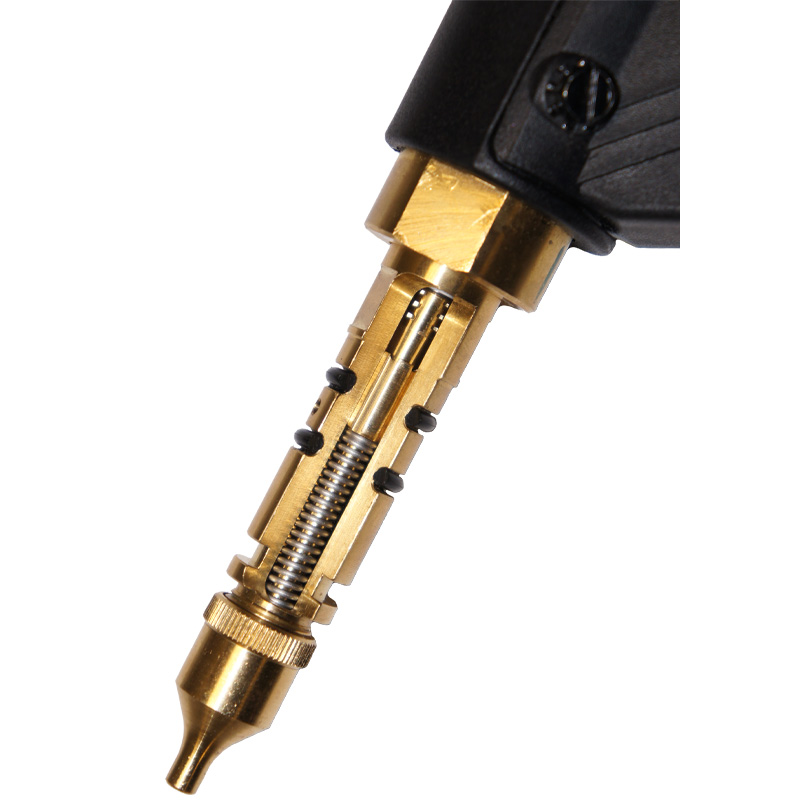Steps for Proper MIG Gun Liner Installation
A MIG gun liner is an important consumable because it can make a significant difference in gun performance and the time and money an operation spends in unplanned downtime. Proper installation of the liner is critical to its ability to guide the wire through the welding cable and up to the contact tip.
Improper liner installation — which includes trimming the liner too short or having a liner that is too long — can result in a number of problems, such as birdnesting, wire feeding issues and increased debris in the liner. These issues can result in costly rework and operator downtime for maintenance and repairs, which impacts productivity. Also, wasted wire due to issues like birdnesting can drive up costs for a company.
Step-by-step installation
The installation process is somewhat similar for all types of MIG gun liners, with some variations. Here are some general steps to consider when installing a new MIG gun liner.

- Before removing the consumables, make sure the gun is straight and the cable is flattened. This makes it easier to feed the liner all the way through.
- Trim the wire at the front of the gun to remove the bead of molten wire that often forms after welding.
- Remove all of the front-end consumables so the liner can be fed through the gun.
- For a conventional liner installation, remove the power pin from the feeder at the back of the gun and cut the wire. This allows the wire and the old conventional liner to be removed from the back of the gun.
- If using a conventional liner, feed the liner through the back of the gun, threading it into the power pin. Reinsert the power pin back into the feeder, and feed a few inches of wire through the back of the power pin.
That way, once all of the consumables are back on at the front of the gun, the wire is already in the gun and ready to be pulled through.
- Because the liner is longer than the gun (designed to accommodate varying gun and cable lengths), there will be liner sticking out the front of the gun, so it’s necessary to trim the liner to the correct length. Conventional liners and front-loading liners may come with a plastic liner trim gauge. This can be fed over the top of the liner and pressed up flush against the neck, so the liner can be trimmed to the end of the gauge. If no gauge is provided, please consult your MIG gun manual or manufacturer’s website for the correct trim length.
- Hit the trigger to pull the wire up, and at the same time purge the gun with shielding gas.
Installing a front-loading QUICK LOAD Liner
There are some variances in the installation process, depending on the type of liner being used. Follow these steps when installing a front-loading liner.

1. Unravel the liner (which comes coiled) and stick the brass end — the end that goes into the receiver at the back of the gun — over the wire and through the neck.
2. Feed the liner through the front of the gun using short strokes, to avoid kinking the liner. The front-loading liner will click or snap into place once it hits the receiver in the power pin.
3. Once that is complete, put the liner gauge on top of the liner and follow the standard installation steps above.
Installing a front-loading liner with the spring-loaded module
The only difference in this installation process is that there is no receiver in the back of the power pin. The receiver is built into the module pin.

- Feed the front-loading liner into the gun using short strokes. The liner will engage with the receiver inside of the module’s power pin. When this happens, the welding operator can feel the liner spring back toward the front of the gun. This is a good sign, because it means the liner is properly engaged.
- Place the liner trim gauge over the front-loading liner until it is flush against the neck.
- Push the liner back into the gun until it bottoms out against the spring-loaded module, then trim the liner flush to the end of the liner trim gauge.
- After trimming, remove the liner trim gauge and release the liner. Note that the liner will spring back and stick out of the neck by approximately 1-3/4 inch, which is normal, as installing the consumables will compress the liner into its proper position.
Retrofitting a gun
The installation process also varies when retrofitting a gun from a conventional liner to a front-loading liner. Here are a few additional things to remember:
- When retrofitting a gun from a conventional liner to a front-loading liner, the first installation will be from the back of the gun, since a receiver is needed on the back in order to accept the front-loading liner.
- After following the standard steps above and removing the conventional liner and wire from the gun, install the end of the front-loading liner with the O-rings on it into the receiver and unravel the liner.
- Feed the front-loading liner in, just as with a conventional liner, through the back of the gun, and thread the receiver into the power pin.
Proper liner installation can help optimize performance
The quality of the liner also can impact welding performance, productivity and operator downtime, so it’s important to buy quality liners from a trusted manufacturer. Choosing the correct size of liner for the wire being used is another way to help maximize performance.
While liners may seem like a small part of the welding operation, it’s important to be mindful of the impact they can have on quality, performance and costs. Liners perform a vital function in the MIG welding process, and the proper installation and maintenance of liners can help reduce costly rework, operator downtime and wasted wire.